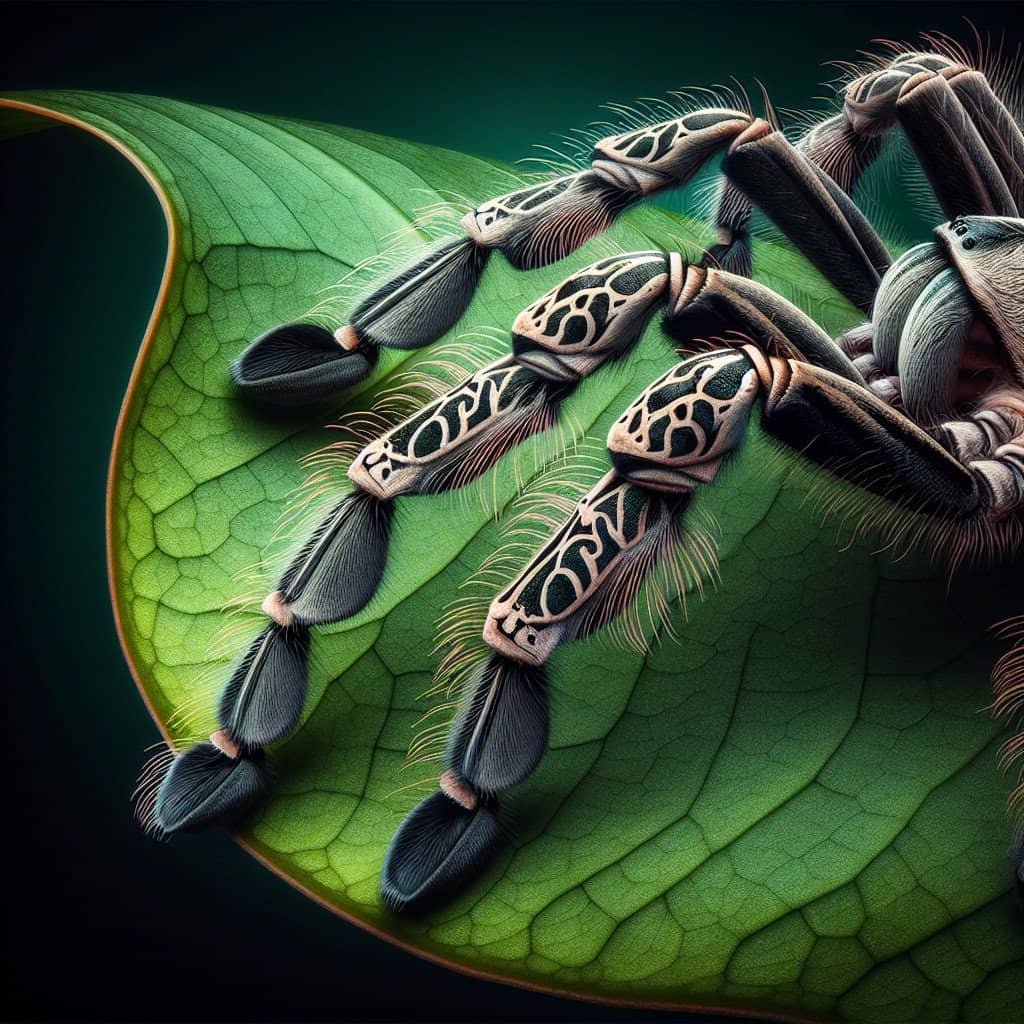Have you ever wondered how to distinguish between arboreal and terrestrial tarantula varieties? With their distinct habitats and behaviors, these two types of tarantulas may require different care and handling. Knowing the key differences between arboreal and terrestrial tarantulas is essential for any enthusiast or prospective owner. In this article, we will explore the characteristics and traits that set these fascinating creatures apart, providing you with valuable insights into the world of tarantula classification.

Physical Characteristics
Size
Tarantula varieties can vary in size, with some species reaching impressive lengths. The size of a tarantula can depend on various factors, including the species and its age. Generally, tarantulas can range in size from a few centimeters to several inches in leg span. It is important to note that the leg span is used to measure the size of a tarantula, as it gives a more accurate representation of its overall dimensions.
Body Coloration
Tarantulas exhibit a wide range of body coloration, which can vary greatly between different species. Some tarantulas display vibrant and striking colors, while others have more subdued hues. The coloration of a tarantula serves multiple purposes, including camouflage, warning potential predators, or attracting mates. It is fascinating to observe the intricate patterns and colors that adorn these incredible creatures.
Leg Span
The leg span of a tarantula is an essential characteristic that can provide valuable information about its habits and lifestyle. Arboreal tarantulas typically have longer and thinner legs, which aid in their movements through trees and vegetation. In contrast, terrestrial tarantulas tend to have shorter and sturdier legs, enabling them to navigate across the ground with ease. The leg span can also be an indicator of a tarantula’s age and overall health.
Habitat Preference
Preferred Locations
Arboreal tarantulas are well-suited for life in trees and can be found in various habitats, including rainforests and jungles. These agile spiders construct intricate webs among branches and leaves or take shelter in tree hollows. On the other hand, terrestrial tarantulas prefer a ground-dwelling lifestyle and can be found in a wide range of habitats, such as deserts, grasslands, and forests. They create burrows or seek refuge under rocks or logs.
Nesting
Arboreal tarantulas construct nests or retreats within trees, using silk to secure their shelter to branches or other structures. These nests provide protection from predators and adverse weather conditions while serving as a base for hunting. Terrestrial tarantulas, on the other hand, prefer to create burrows in the ground. These burrows serve as a safe haven where the tarantula can rest, molt, and retreat when threatened.
Burrowing
While both arboreal and terrestrial tarantulas utilize burrows, the digging behavior between the two can differ. Arboreal tarantulas often build shallow burrows in trees, which serve as a starting point for their web-building activities. These burrows are typically more exposed and may not provide as much protection as those created by terrestrial tarantulas. Terrestrial tarantulas, on the other hand, are expert diggers and can construct deep and intricate burrows underground, providing excellent protection and insulation.
Web-building Behavior
Web Structure
Arboreal tarantulas are known for their elaborate and intricate web structures. The webs of these spiders are typically designed to capture prey that ventures into the tree canopy. They create a combination of horizontal and vertical silk threads, forming a complex network. In contrast, terrestrial tarantulas are less likely to rely on web-building as their primary hunting technique. Instead, they often utilize their agility and speed to catch prey directly.
Web Placement
Arboreal tarantulas strategically place their webs in locations where they are most likely to encounter prey. These locations often include areas with an abundance of insects or near potential hiding spots for the tarantula. The intricate web is suspended between branches or foliage, creating a trap for unsuspecting prey. Terrestrial tarantulas, as their name suggests, typically do not construct elaborate webs but may create simpler versions near their burrows to detect vibrations caused by approaching prey.
Web Maintenance
Maintaining a web is crucial for tarantulas that rely on it for hunting. Arboreal tarantulas regularly inspect and repair their webs, ensuring that it remains in optimal condition. They remove debris, fix any damaged silk strands, and reposition the web to maximize its effectiveness. Terrestrial tarantulas, while not as reliant on webs, may still perform maintenance activities, such as removing excess prey remains or reinforcing any areas of their burrow that have worn out.
Feeding Habits
Prey Preference
Tarantulas are carnivorous predators and have a varied diet depending on their habitat and size. While both arboreal and terrestrial tarantulas feed on insects, their prey preferences can differ slightly. Arboreal tarantulas primarily capture flying insects, such as moths, beetles, and flies, as their webs are better suited for trapping aerial prey. Terrestrial tarantulas, on the other hand, are more likely to target ground-dwelling creatures like crickets, grasshoppers, and small rodents.
Hunting Techniques
Arboreal tarantulas rely heavily on their webs to hunt. When an unsuspecting insect flies into the web, the tarantula quickly immobilizes it by delivering a venomous bite. The tarantula then wraps the prey in silk before consuming it. In contrast, terrestrial tarantulas are often ambush predators, using their stealth and speed to capture prey in their vicinity. They may pounce on their victims or use their strong fangs to deliver a quick and fatal bite.
Feeding Frequency
The feeding frequency of tarantulas can vary depending on factors such as environmental conditions, prey availability, and the tarantula’s size and age. Generally, tarantulas have a relatively low metabolic rate and can survive for extended periods without food. In optimal conditions, adult tarantulas may feed once every couple of weeks, while spiderlings (young tarantulas) may require more frequent meals. It is important to provide tarantulas with a balanced and varied diet to ensure their overall health.

Territorial Behavior
Preferred Territory
Tarantulas, both arboreal and terrestrial, exhibit territorial behavior to varying degrees. Arboreal tarantulas tend to have a broader range, as they need to move between trees and establish multiple hunting sites. They may compete for territories with other tarantulas and defend their preferred location. Terrestrial tarantulas, while still territorial, typically have a smaller territory centered around their burrow. They are more likely to engage in aggressive behavior when their territory is threatened.
Aggressiveness
Tarantulas, despite their intimidating appearance, are generally not aggressive towards humans unless provoked or feeling threatened. However, when it comes to interactions between tarantulas, territorial disputes or competitions for mates can lead to aggressive behavior. Arboreal tarantulas are usually more skittish and may employ defensive mechanisms, like flicking tiny barbed hairs from their abdomen, to discourage predators or perceived threats. Terrestrial tarantulas, due to their solitary nature, may exhibit a higher level of aggression within their own species.
Defensive Mechanisms
To protect themselves from potential threats, tarantulas have developed various defensive mechanisms. When provoked, they may rear up on their hind legs, exposing their fangs as a warning. Some tarantulas can also produce a hissing or rattling sound by rubbing their leg spines together, further deterring predators. Additionally, tarantulas possess specialized urticating hairs on their abdomen, which can cause irritation or allergic reactions when released into the air, providing a physical defense against predators.
Activity Patterns
Diurnal or Nocturnal
Arboreal and terrestrial tarantulas can exhibit different activity patterns when it comes to their preferred time for hunting and other behaviors. Arboreal tarantulas are often nocturnal, being most active during the night when their prey, such as moths and flying insects, are abundant. They are specially adapted to navigate in low-light conditions, with their keen senses and sensitive leg hairs guiding them through the darkness. Terrestrial tarantulas, in contrast, can be either diurnal or nocturnal, depending on the species and the environmental conditions they inhabit.
Circadian Rhythms
Tarantulas, like many other creatures, have internal circadian rhythms that dictate their physiological and behavioral processes. These rhythms are influenced by factors such as light, temperature, and hormonal fluctuations. While the specific circadian rhythms of tarantulas are not yet well understood, it is believed that they play a role in regulating various functions, such as activity levels, feeding, mating, and molting. Further research is needed to explore the intricacies of circadian rhythms in tarantulas.
Movement
Arboreal tarantulas have adapted to life in trees and exhibit specialized movement behaviors to navigate their environment successfully. They possess longer and thinner legs, which allow them to move adeptly along branches and foliage. They use a combination of walking and climbing movements, utilizing their sharp claws to grip onto surfaces. Terrestrial tarantulas are more adapted for ground movement, utilizing their muscular legs to walk or run across the substrate with agility and speed.

Reproduction
Mating Rituals
The mating rituals of tarantulas can be quite elaborate and intricate, varying between species. Female tarantulas often release pheromones to attract male suitors. Male tarantulas, in response, perform a courtship dance, which involves tapping their legs and abdomen on the ground or vibrating their bodies in a rhythmic pattern. The precise ritual may differ between species, with some involving extensive displays and others being relatively simpler. The male carefully approaches the female, and if successful, transfers his sperm to the female’s reproductive organs.
Egg-laying Process
After a successful mating, the female tarantula goes through a process known as egg-laying or oviposition. The female constructs a silk sac or egg sac, where she deposits a batch of fertilized eggs. The sac provides protection and a suitable environment for the developing spiderlings. The female diligently guards the sac, occasionally rotating or adjusting its position to regulate temperature and humidity. The size of the egg sac and the number of eggs can vary considerably between species.
Parental Care
In some species of tarantulas, females exhibit extensive parental care, while in others, they may abandon the egg sac shortly after laying it. Tarantulas with prolonged parental care will protect, feed, and even transport the hatched spiderlings on her back until they are capable of fending for themselves. This behavior is more commonly observed in terrestrial tarantula species. The provision of parental care increases the survival rate of the offspring, ensuring a successful generation.
Lifespan and Growth Rate
Average Lifespan
The lifespan of tarantulas can vary greatly depending on factors such as species, habitat, and environmental conditions. On average, tarantulas live several years, with some individuals reaching ages of 10 to 20 years or even longer. Female tarantulas typically have a longer lifespan compared to males, as males often die shortly after mating. It is worth noting that these estimates are general guidelines and can vary among different species.
Growth Periods
Tarantulas undergo multiple growth periods throughout their lives, shedding their exoskeletons in a process called molting. Young tarantulas, known as spiderlings, molt more frequently as they grow rapidly. As they mature, the frequency of molting decreases, and the growth rate slows down. Factors such as temperature, humidity, and food availability can influence the growth period of a tarantula, with optimal conditions promoting healthier and more consistent growth.
Molting Frequency
Molting is a crucial process that allows tarantulas to grow and develop. During molting, a tarantula sheds its old exoskeleton, revealing a soft and vulnerable new exoskeleton. The tarantula will remain in this vulnerable state until the new exoskeleton hardens. The frequency of molting can vary, with young tarantulas molting more frequently than adults. On average, tarantulas may molt several times a year, though this can vary depending on the species and individual conditions.

Native Regions
Distribution
Tarantulas can be found in various regions around the world, with different species inhabiting specific areas. They have a broad distribution, spanning continents such as North America, South America, Africa, Asia, and Australia. Each region has its own unique tarantula species, with diverse characteristics and adaptations to their specific ecosystems and climates.
Preferred Ecosystems
Arboreal tarantulas thrive in lush and forested ecosystems, such as rainforests, jungles, and cloud forests. These habitats provide an abundance of trees and vegetation, allowing arboreal tarantulas to construct their intricate webs and traverse the canopy. Terrestrial tarantulas, meanwhile, can adapt to a wider range of ecosystems. They can survive in deserts, grasslands, scrublands, and even some urban environments, provided there is suitable shelter and prey availability.
Climate Adaptation
Tarantulas have adapted to various climates and can be found in environments with different temperature and humidity levels. Some species are adapted to hot and arid climates, withstanding high temperatures and limited water availability. Others thrive in more temperate or tropical climates, where humidity and moisture are abundant. Tarantulas have evolved to survive and reproduce in diverse climates by utilizing their unique characteristics and behaviors.
Popular Varieties
Arboreal Tarantula Examples
-
Pink Toe Tarantula (Avicularia avicularia): This species is known for its striking coloration and agile climbing abilities. It is native to South America and can be found in the rainforests of countries such as Brazil and Suriname.
-
Goliath Birdeater (Theraphosa blondi): As one of the largest tarantula species in the world, this arboreal tarantula is native to the rainforests of South America. Despite its name, it primarily preys on insects and small vertebrates.
Terrestrial Tarantula Examples
-
Chilean Rose Hair Tarantula (Grammostola rosea): This terrestrial tarantula is one of the most popular pet species due to its docile nature and ease of care. It is native to Chile and can be found in arid scrubland habitats.
-
Mexican Red Knee Tarantula (Brachypelma smithi): This species is known for its striking coloration, with red-orange bands on its legs. It inhabits the scrublands and deserts of Mexico and is highly sought after by tarantula enthusiasts.
Unique Characteristics
While all tarantulas share common characteristics, some species possess unique traits that set them apart. One example is the Brazilian Wandering Spider (Phoneutria spp.), which is known for its highly potent venom and aggressive behavior. Another unique species is the Blue Tarantula (Poecilotheria metallica) from Southeast Asia, prized for its stunning metallic blue coloration. These unique characteristics make these tarantulas particularly fascinating and sought after by enthusiasts and collectors alike.
In conclusion, arboreal and terrestrial tarantula varieties exhibit distinct physical characteristics, habitat preferences, web-building behavior, feeding habits, territorial behavior, activity patterns, reproductive processes, lifespan, and native regions. Understanding the differences between these tarantula varieties allows us to appreciate their incredible diversity and adaptability in the natural world. Whether you find yourself captivated by the agility of arboreal tarantulas or the stealth of terrestrial tarantulas, these remarkable creatures continue to awe and fascinate both researchers and enthusiasts.

